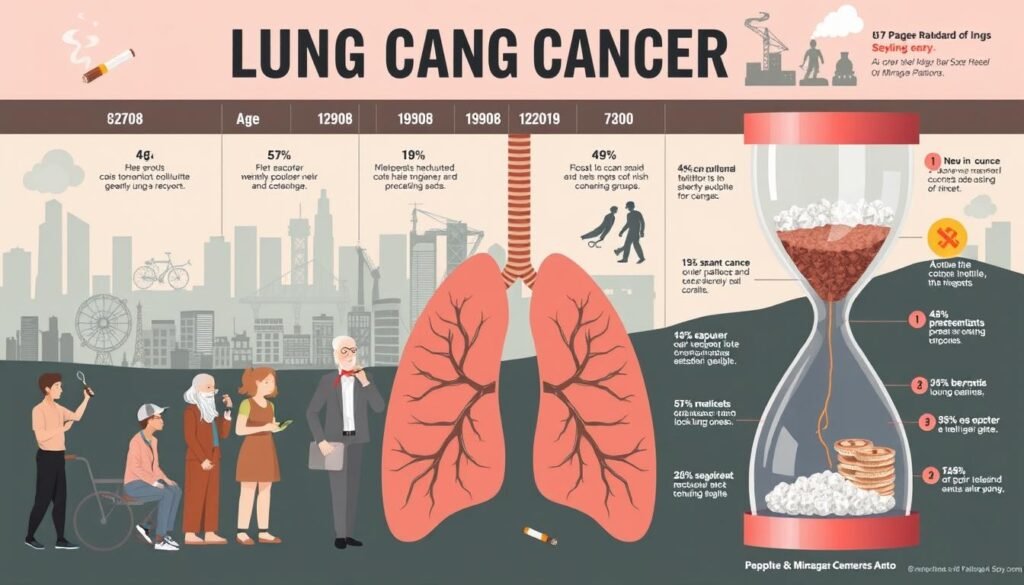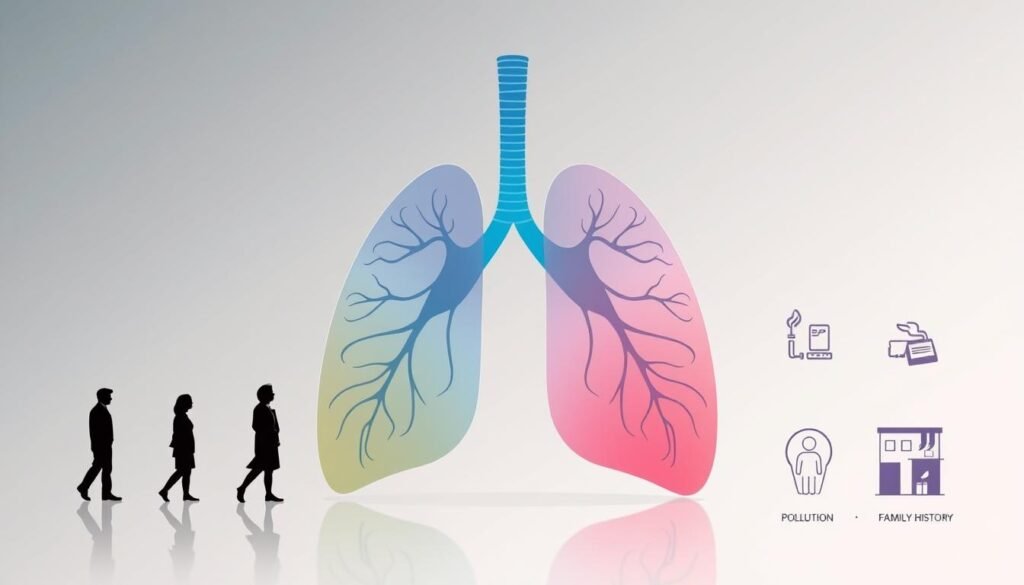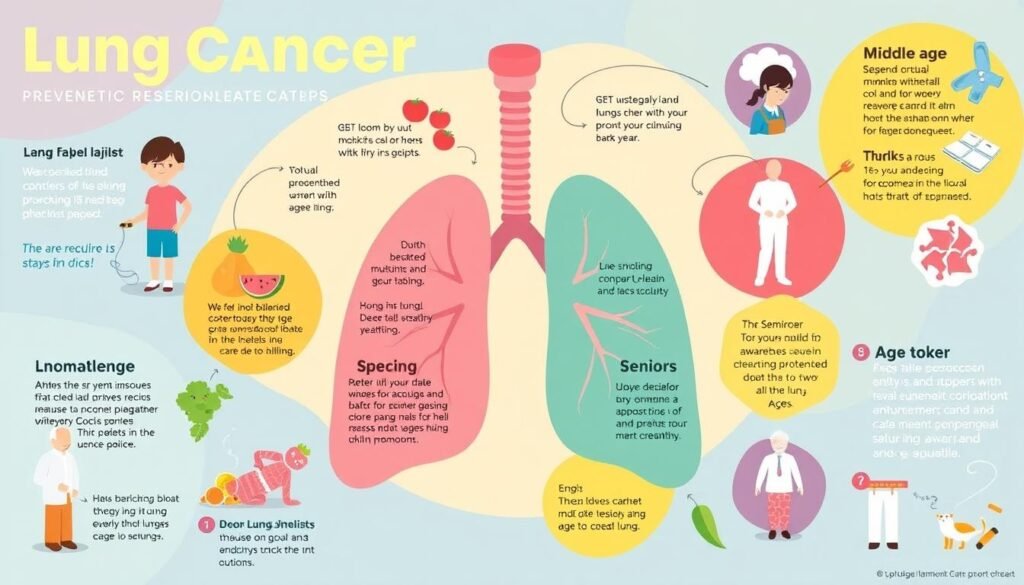Did you know the average age for lung cancer diagnosis is about 70 years? This fact shows lung cancer can affect those still very active in life, not just the elderly. It’s the second most common cancer in both men and women in the U.S. Also, it leads in cancer deaths, making up 20% of the total.
Lung cancer mainly affects those 60 or older, with most new cases in this age group. We must look closely at how age relates to lung cancer. We’ll check out trends, risk factors, and how to prevent it for everyone.
Key Takeaways
- The average age at diagnosis for lung cancer is approximately 70 years.
- Over half of lung cancer cases occur in individuals aged 60 years and older.
- Lung cancer is the leading cause of cancer death in the U.S.
- The disease is more prevalent in men, with significant demographic disparities.
- Age plays a crucial role in understanding lung cancer risk factors and screening.
- Preventative measures are essential for reducing risks in both older and younger populations.
- Regular screening can aid in early detection, improving outcomes for various age groups.
Lung Cancer Overview
Lung cancer is a major health concern in the United States. It is complex due to various contributing factors. Knowing the types of lung cancer affects how we diagnose and treat the disease. It is crucial to understand these for early detection and effective treatment.
Types of Lung Cancer
Non-small cell lung cancer (NSCLC) and small cell lung cancer (SCLC) are the main types. Around 80-85% of all lung cancer cases are NSCLC. This type includes adenocarcinoma, squamous cell carcinoma, and large cell carcinoma.
Adenocarcinoma, specifically, is now the most common, making up about 33% of cases. This reflects a big change from before, where it was just 4%. For those under 40, adenocarcinoma represents nearly half of all cases.
Prevalence and Incidence Rates
In 2021, about 235,760 new cases of lung cancer were diagnosed. Despite less smoking, lung cancer still impacts many people. Notably, 7% of patients now are diagnosed at 25 or younger, a rise from 2% before.
Lung cancer is found in the U.S. every two minutes. This shows how vital ongoing awareness and actions are. Screening, like low-dose CT scans, might cut death rates by up to 20%. For info on early signs of lung cancer, visit this resource.
Understanding Lung Cancer Age Range
Data on lung cancer patients show important insights into who gets this disease. It’s mostly older adults who are diagnosed with lung cancer. Those over 65 years old are particularly at risk, pointing to the need for focused efforts to help this group.
Demographics of Lung Cancer Patients
Lung cancer is a major health issue in the US, affecting about 235,000 people each year. Most patients, about 90%, are over 65. Very few young adults, only about 1.37%, get lung cancer. This shows the importance of understanding lung cancer risks at any age.
Age at Diagnosis Statistics
Youth tend to find out they have lung cancer at stage IV, around half of the time. This age group faces unique challenges, like a higher rate of certain gene mutations. Highlighting the need for early detection and the right treatment is crucial for better outcomes.
| Age Group | Percentage of Total Cases | Average Age at Diagnosis | Stage IV Diagnosis Rate |
|---|---|---|---|
| 18-35 years | 1.37% | Approx. 30 years | 49.21% |
| 36-50 years | 8.5% | Approx. 45 years | 25% |
| 51-64 years | 30% | Approx. 58 years | 22% |
| 65 years and older | 60% | Approx. 71 years | 18% |
Lung Cancer Incidence by Age
Lung cancer affects different age groups in unique ways. Knowing this helps with early detection and treatment. Most lung cancer cases are in people aged 75 to 79. The 80 to 84 age group is also highly affected. This shows that lung cancer rates go up with age.
Distribution of Cases Among Age Groups
Age is a big factor in lung cancer cases. In 2018, the U.S. had a lung cancer death rate of 34.8 per 100,000 people. Kentucky’s rate was very high at 53.5. However, Utah’s rate was much lower at 16.4. These numbers show that lung cancer is more common in older adults. For more info, see the American Cancer Society statistics.
Trends in Lung Cancer Diagnosis Over the Years
The number of lung cancer cases is generally going down. But more young adults who don’t smoke are getting diagnosed. This is especially true for women aged 40 to 49. They have higher lung cancer rates than men of the same age. We need to look into new risk factors to help everyone better.
Lung Cancer Risk Factors by Age
Aging greatly affects the chance of getting lung cancer. Most people are diagnosed at about 70 years old. A lot of new cases are found in folks who are 60 or older. This age group, especially those between 75 to 79, has the highest rates. It’s key to know how age plays with other risk factors to prevent and find lung cancer early.
Role of Age in Lung Cancer Risk
As people get older, their lung cancer risk factors age go up. More than half of lung cancer patients are between 55 and 74 years old. How long people live with lung cancer changes a lot with age. For instance, patients over 60 tend to live about 37.8 weeks. That’s much shorter compared to 57 weeks for those who are younger.
Impact of Lifestyle and Environment on Different Age Groups
Lifestyle impact on lung cancer risk is huge. Smoking is the main risk, especially for men over 65. Even nonsmokers who breathe in secondhand smoke face a 20 to 30 percent increased cancer risk. Other risks like radon affect all ages. Plus, race matters too. Black men are 15 percent more likely to get lung cancer than white men.

Lung Cancer Symptoms Across Different Ages
Lung cancer symptoms vary between younger and older adults. This affects when the disease is found and how it is treated. Knowing about these differences is vital for catching the disease early and helping patients get better.
Common Symptoms in Younger Adults
Younger adults often display less obvious symptoms. These can easily be missed. Symptoms they report include:
- Fatigue, which might seem like just being tired.
- Shortness of breath, usually during activities.
- Nausea, which could be thought to be from other, non-serious issues.
- Fever and abdominal pain, seen more in those under 35.
- Less common symptoms are persistent cough and feeling uncomfortable in the chest.
Symptoms Frequently Observed in Older Adults
Older adults tend to show clearer signs of lung cancer. This helps doctors find the disease sooner. These signs include:
- Persistent cough that stays around.
- Coughing up blood, which points to a serious condition.
- Chest pain that gets worse when breathing deeply.
- Many older patients, about 55%, have bad shortness of breath.
- A majority also feel fatigue, likely due to the cancer spreading.
Understanding lung cancer symptoms for each age group is crucial. Young people might wait to get help because their signs are vague. Older people might think their symptoms are just part of getting older. If you have unexplained or long-lasting symptoms, see a doctor. They might be signs of lung cancer.
| Age Group | Common Symptoms | Symptom Prevalence |
|---|---|---|
| 20-34 | Fatigue, Shortness of Breath, Nausea | High |
| 35-44 | Fatigue, Shortness of Breath, Cough | Moderate |
| 45-54 | Persistent Cough, Chest Pain | Moderate |
| 55-64 | Persistent Cough, Coughing Up Blood | High |
| 65-74 | Coughing Up Blood, Chest Pain | Very High |
| 75+ | Persistent Cough, Shortness of Breath | Very High |
Lung Cancer Screening Age Recommendations
Screening for lung cancer is important, especially as people get older. The American Cancer Society says yearly screenings with low-dose CT scans should happen for those 50 to 80 years old. This is for people who have smoked a lot over the years. Catching lung cancer early leads to better chances of managing it.
Importance of Early Detection in Aging Populations
Screening early helps catch lung cancer soon, which can save lives. Most people find out they have lung cancer at age 70. So, older adults really need to get screened well. Getting screened every year is better than every two years. It means doctors can find the cancer sooner. Thanks to new rules, 5 million more people can get screened every year.
Guidelines for Screening in Younger Adults
Now, there’s talk about screening younger adults too. Some younger people show unusual signs of lung cancer. Experts are looking into screening them based on their risks. Talking with doctors about who should get screened is key. This helps make sure the right people get screened at the right time. This approach could help find lung cancer early in more people.
| Age Group | Recommended Screening | Pack-Year History Required |
|---|---|---|
| 50-80 Years | Annual LDCT | 20 Pack-Year |
| Under 50 Years | Individual assessment needed | Varies |
Lung Cancer Treatment Options by Age
Treatment choices for lung cancer change with the patient’s age. Knowing the options for seniors versus younger people improves care. This focus helps doctors tailor care for each person.
Variances in Treatment Approaches for Older Adults
Older patients have unique challenges in lung cancer care. Many over 80 with stage 3 lung cancer get no treatment after diagnosis. Doctors need to weigh the benefits and risks, considering other health issues.
- Surgeries like wedge resection and lobectomy are safe for seniors.
- VATS offers better recovery for the elderly than open surgery.
- SBRT works even for those 90+, offering hope for early-stage cancer.
Effective Treatment Strategies for Younger Patients
Younger patients can handle tougher treatments. Their care teams offer a mix of therapies:
- Adjuvant chemotherapy helps those over 75 after lung cancer surgery.
- Using chemoradiation after chemotherapy helps those 70 and older.
- Younger folks do well with targeted therapies like gene therapy.
Everyone with this kind of lung cancer should get genetic testing. It helps find the right FDA-approved treatment based on their genes.
| Age Group | Common Treatment Options | Treatment Tolerance |
|---|---|---|
| Under 70 | Adjuvant Chemotherapy, Targeted Therapy | Higher tolerance for aggressive approaches |
| 70 and Older | VATS, SBRT, Chemoradiation | Generally good tolerance, mindful of comorbidities |
| 80 and Older | Wedge Resection, Palliative Care | Cautiously monitored due to higher risk factors |
Age-focused treatment strategies lead to better care. They make patients happier and healthier.
Lung Cancer Prognosis Age Correlation
Understanding the link between age and lung cancer prognosis is key for better treatments. Being older often means having a harder time with lung cancer, especially with survival rates and how treatments work. Studies highlight how age affects the outlook for people with lung cancer.
Survival Rates by Age Group
Research finds that lung cancer affects older people more harshly. Those over 60 have a median survival of just 37.8 weeks. This is much less compared to younger patients, who have around 57 weeks. The 1-year survival rate for older patients is 42.5%, while it’s 67.3% for the younger ones. This gap shows how critical age is for lung cancer prognosis.
Factors Influencing Prognosis Beyond Age
Age is crucial, but other aspects matter too in lung cancer prognosis. Things like the cancer’s stage, overall health, and tumor traits affect survival. Elderly with non-small cell lung cancer and high LDH levels often live shorter. Grasping these aspects helps create personalized treatment plans.
| Age Group | Median Survival Time (Weeks) | 1-Year Survival Rate (%) |
|---|---|---|
| Under 60 | 57 | 67.3 |
| 60 and Over | 37.8 | 42.5 |

Lung Cancer Mortality Age Trends
Lung cancer is the top killer among cancers in the USA, with age showing big gaps in death rates. It’s key to grasp these trends for health efforts and early action. By looking at current data, we can understand these worrying rates, which is vital for helping those impacted.
Statistics on Lung Cancer Death Rates by Age
Stats show that lung cancer death rates increase with age. People between 75 and 79 years old are most at risk. Among men 85 to 89, the rate hit a high of 585.9 per 100,000 person-years. For women 75 to 79, the rate was 365.8 per 100,000. This points out men are more affected, especially between 70 to 79 years, with ratios of 2.46 to 3.01.
Analysis of Mortality Trends Over Time
Over time, lung cancer deaths have slowly dropped, mainly thanks to fewer people smoking. From highs in 1990 and 2002, deaths fell significantly—59% for men and 34% for women. Yet, this cancer is still a major issue, particularly for the elderly. In 2021, it caused 22% of all cancer deaths in the U.S., totaling 134,592 deaths.
The difference in death rates between genders is also clear, with men (37.4 per 100,000) suffering more than women (27.3 per 100,000). Race and ethnicity add to the complexity. Black men saw the highest rates, at 51.0 per 100,000 during 2016-2020. Highlighting these age trends not only spreads awareness but underlines the urgency for focused prevention and therapy plans.
More details on lung cancer mortality offer deeper insight into worldwide gaps and the seriousness of these stats.
Lung Cancer Prevention Strategies by Age
Lung cancer prevention methods vary for different ages. Older adults have a higher risk and need specific strategies. For young people, education on awareness and prevention helps a lot.
Preventative Measures for Older Adults
Older adults face lung cancer risk due to factors like past smoking and environmental exposure. It’s crucial to implement strategies for lung cancer prevention. These strategies should focus on:
- Stopping smoking greatly lowers risk, as smokers are about 20 times more likely to get lung cancer than non-smokers.
- It’s important to get regular health checks. Sadly, only 12.7% of those between 55-80 years old meet the screening criteria. This shows we need better screening rates.
- Lessening exposure to pollutants, such as dirty outdoor air, can also reduce risk. High exposure increases lung cancer risk by around 40%.
Awareness and Education for Younger Populations
Young people also need to know their risks. Knowing about symptoms and risk factors is key because lung cancer rates are going up in this group. Awareness programs are focused on:
- Spotting symptoms early in younger folks, leading to quicker interventions.
- Pushing for smoke-free spaces. Being around secondhand smoke ups lung cancer risk by 20% for non-smokers.
- Starting conversations on potential exposure to things in the environment that could cause lung cancer.
Educational programs are vital for lung cancer prevention in the young. They motivate young people to live healthier and stay informed about screening. You can find info on screening tests and criteria for different ages on health websites. This highlights the benefits of catching the disease early.

| Preventative Measures | Target Age Group | Expected Outcomes |
|---|---|---|
| Smoking cessation | Older Adults | Reduced lung cancer mortality |
| Health screenings | Older Adults | Improved early detection rates |
| Awareness campaigns | Young Adults | Increased symptom recognition |
| Smoke-free policies | All Ages | Decreased secondhand smoke exposure |
Conclusion
Knowing who gets lung cancer by age is key in better awareness, finding, and treatment. While not common in young people under 45, it’s growing, especially in women. This means we need special ways to check for lung cancer and teach people about its risks in different groups.
Lung cancer in the young often takes a certain form called adenocarcinoma. Many who get it have smoked. Finding lung cancer early is super important. Also, certain gene changes point to new treatments. This info helps doctors create custom care, improving how well treatments work.
Things keep changing, so we must keep learning and teaching about lung cancer. By knowing more about its risks and how it can look different in everyone, we can help fight it. We aim to lessen lung cancer’s spread by understanding the big picture and spreading that knowledge.